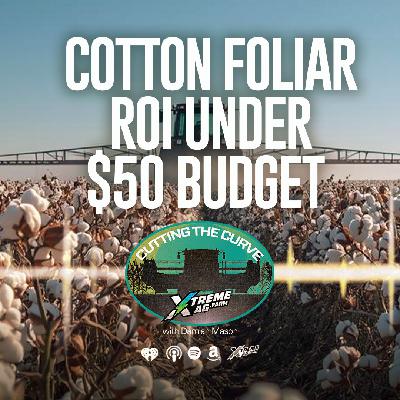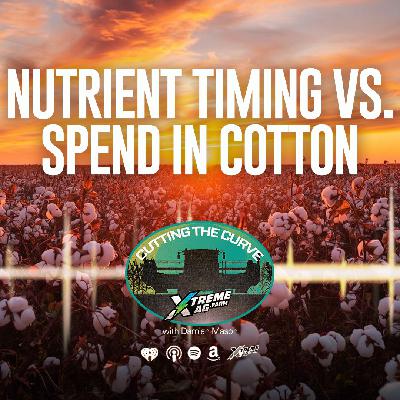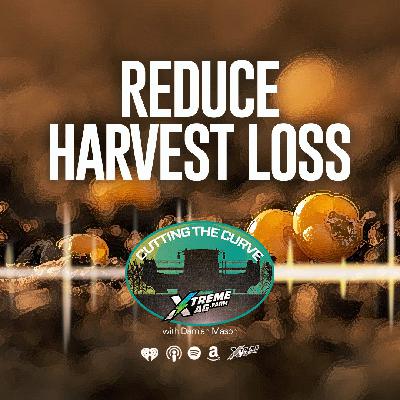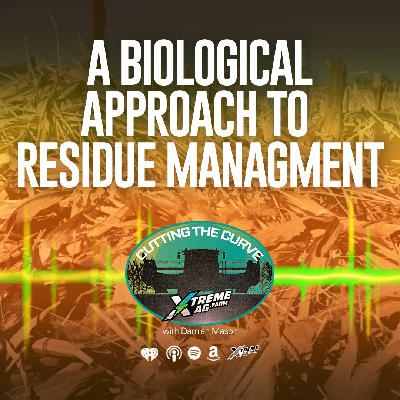Discover XtremeAg: Cutting The Curve Podcast
XtremeAg: Cutting The Curve Podcast

XtremeAg: Cutting The Curve Podcast
Author: XtremeAg
Subscribed: 49Played: 3,442Subscribe
Share
© Copyright 2025 All rights reserved.
Description
XtremeAg’s Cutting the Curve Podcast, one of the best farming podcasts in America, hosted by Damian Mason. In each episode, top American farmers share their proven strategies for boosting crop yields and improving farm ROI. Learn from farming experts who provide tips on regenerative agriculture, new farm equipment, fertilizer recommendations, agronomy and farm efficiency. Whether you want to improve your crop yield for corn or soybeans, explore sustainable farming practices, or optimize your nutrient management, the Cutting the Curve Podcast delivers insights you can apply to your farming operation today. Stay ahead of the curve in the ever-evolving world of agriculture. https://www.xtremeag.farm/podcasts
394 Episodes
Reverse
In this episode of Cutting The Curve, Damian Mason hosts Temple Rhodes, Chad Henderson, Kevin Matthews, Joe Leslie, and agronomist Stephanie Zelinko to discuss the Economic Fertility Challenge—a collaborative in-furrow fertility trial with AgroLiquid, aiming to maximize ROI under a $40/acre fertility budget. The challenge was conducted on irrigated corn with a 300-bushel yield goal, testing varied nutrient strategies across different farms without revealing treatment identities to eliminate bias. The discussion emphasizes budget-conscious fertility planning, precision placement, and how real-world application on different soil types impacts results. Farmers share insights on phosphorus prioritization, micronutrient selection, and the efficiencies gained from targeted in-furrow applications—highlighting that agronomic effectiveness and profitability can be achieved even under financial constraints.
In this episode of Cutting the Curve, Damian Mason hosts Temple Rhodes and agronomist Rebekah Muench of Concept Agritek to address how growers can reduce phosphorus fertilizer costs without sacrificing yield. With phosphorus sources like DAP and MAP becoming prohibitively expensive, the conversation centers on improving phosphorus efficiency by unlocking tied-up nutrients in the soil, utilizing banded and seasonally timed applications, and enhancing microbial activity through residue management. Muench explains the science behind phosphorus availability and tie-up, while Rhodes shares practical methods from his own operation, including a transition to liquid fertility, pH optimization, and spoon-feeding nutrients during key growth stages. The episode offers practical, cost-saving strategies to maximize phosphorus ROI under tightening margins.
Presented by BASF
In this episode of Cutting The Curve, host Damian Mason is joined by Kevin Matthews and Jeremy Geerts from SprayTec to explore the hidden costs and risks associated with foam in spray applications. Excess foam in the spray tank can reduce effective volume, distort herbicide rates, tie up active ingredients, and cause off-target environmental contamination. The conversation outlines how foam affects agronomic performance and profitability, including increased risk of weed resistance and wasted product. Jeremy provides insights into proper tank mixing practices and how SprayTec's FullTec adjuvant supports foam mitigation and water conditioning. Kevin shares real-world management tips to ensure accurate applications and improved efficacy.
In this special edition of Cutting the Curve, Damian Mason sits down with the next generation of XtremeAg contributors—Connor “Vern” Garrett, Alexander Evans, Danielle Venable, Jackson Henderson, and Layne Miles—joined by Caleb Coots of Teva Ag. The discussion centers on adaptability in agriculture: economic pressures, changes in herbicide regulations, evolving input strategies, and shifting mindsets. With real-world examples from each operation, the group explores how young ag professionals are responding to tighter margins, input bans, changing technologies, and the stress of expansion. They also challenge conventional ideas around growth, highlighting the need for operational efficiency and long-term sustainability.
Presented by TEVA
In this episode of Cutting the Curve, host Damian Mason discusses the Economic Fertility Challenge focused on cotton production with XtremeAg farmer Matt Miles and fellow contributors Kevin Matthews, Kelly Garrett, agronomist Stephanie Zelinko, and Gabe Saxon from AgroLiquid. The challenge, held on Matt Miles’ Arkansas farm, tested various foliar nutrition strategies on cotton under a strict $50 per-acre budget. With different teams applying nutrients using alternate timing and formulation methods, the goal was to evaluate return on investment (ROI) and yield efficiency in the face of tightening commodity margins. Despite differences in regional experience and field conditions, all participants emphasized strategic potassium management and spoon-fed foliar nutrition to optimize yields. Results from this collaborative trial offer valuable insights for improving nutrient efficiency and profitability, even beyond cotton.
In this episode of Cutting the Curve, XtremeAg tackles the widespread skepticism surrounding post-patent (generic) crop protection products. Host Damian Mason speaks with Brian Adams of Volunteer Ag Services and Bret Corbett of Albaugh to explore the misconceptions about generics, their formulation quality, and their role in modern farming systems. The conversation emphasizes that while not all generics are created equal, many U.S.-manufactured post-patent products undergo rigorous testing, comply with EPA standards, and often contain updated surfactants and adjuvants. The panel outlines how farmers can confidently adopt these inputs by evaluating product sourcing, compatibility, and supplier credibility—offering a cost-effective strategy in today’s challenging ag economy.
In this candid episode of Cutting the Curve, Damian Mason hosts a roundtable with members of the next generation of agriculture—Alexander Evans, Connor “Vern” Garrett, Danielle Venable, Jackson Henderson, and Layne Miles—joined by Caleb Coots of TEVA Ag. The group shares how they balance personal time with the demands of farming, how their identities are shaped by agriculture, and why building family traditions off the farm is as vital as yield goals. Topics include drag racing, falconry, parenting, mental health, generational expectations, and the pressure to embody the "farmer" identity 24/7. A thoughtful look into how young ag professionals are reshaping what it means to live and work in production agriculture today.
Presented by TEVA
In this episode of Cutting the Curve, host Damian Mason is joined by Matt Miles and agronomist Stephanie Zelinko to break down the results of a cotton fertility challenge conducted in partnership with AgroLiquid. The trial, hosted on Matt's farm, tested three fertility programs designed by Matt, Kevin Matthews, and Kelly Garrett, each limited to a $50 foliar application budget with the goal of achieving 1,750 lbs (3.5 bales) per acre. Despite different application timings and nutrient mixes, all three programs yielded strong results, with Matt’s at 1,806 lbs, Kelly’s at 1,800 lbs, and Kevin’s at 1,724 lbs. The key differentiator was nutrient timing, especially consistent potassium and calcium delivery throughout the crop’s reproductive phase. The discussion emphasizes cotton’s high nutrient demands, the role of spoon-fed foliar treatments, and opportunities to trim costs without sacrificing yield by strategically managing application timing and product selection.
In this episode of Cutting the Curve, host Damian Mason is joined by Tennessee farmer Johnny Verell and Keith Miller from Albaugh to discuss how farmers can reduce unnecessary crop protection costs without compromising control. The conversation focuses on leveraging post-patent and rebranded legacy chemistries, improving input planning, addressing water quality factors like pH and hardness, and reevaluating fungicide, insecticide, and herbicide use based on agronomic need. As resistance grows and commodity prices stay low, the episode outlines practical, data-backed strategies to optimize input spend and maintain performance by returning to proven, cost-effective agronomic fundamentals.
In this episode of Cutting the Curve, Damian Mason talks with Todd Dale of Estes Concaves about optimizing harvest operations under variable and adverse field conditions. They discuss the agronomic and economic impacts of inconsistent moisture levels, disease pressure like tar spot and southern rust, and high-yield variability. Todd explains how upgrading to high-performance concaves—like the XPR series from Estes—can improve threshing efficiency, reduce mechanical grain damage, and significantly minimize harvest loss. He outlines how rotor loss, separator hours, and poor grain quality directly affect profitability and trade-in value. The conversation provides clear insight into how mechanical upgrades to combines can drive operational efficiency and protect margins during low commodity pricing cycles.
Presented by BASF
In this Cutting the Curve episode, XtremeAg farmers Chad Henderson, Matt Miles, and Temple Rhodes, along with AgroLiquid agronomists Gabe Saxon and Stephanie Zelinko, explore fertility strategies for maximizing double crop soybean yields. Each team worked within a $40 foliar fertility budget, customizing nutrient programs based on specific field conditions and crop goals. Applications were timed at the R3 growth stage to align with fungicide passes and minimize additional fieldwork. Despite environmental constraints—especially heat and limited growing windows—participants pursued combinations of nitrogen, potassium, phosphorus, magnesium, calcium, and micronutrients. The trial aimed to evaluate which nutrients, if any, could consistently push yields beyond the common 60–70 bushel range and toward the elusive 80-bushel target in double crop soybean systems.
In this episode of XtremeAg’s Cutting the Curve, Lee Lubbers of Gregory, South Dakota, shares his experience with innovative tile drainage strategies, including in-season installation during planting. Despite conventional wisdom warning against springtime drainage due to compaction and crop loss, Lubbers reports minimal disruption and significant yield improvements. He has installed over 3,000 acres of tile, enhancing soil structure, increasing organic matter, and reducing waterlogging. Alongside ADS representatives Cole Rath and Tim Dahl, the discussion also covers the growing role of water recycling through retention ponds, including collaborative projects that benefit wildlife and neighboring livestock operations. This episode highlights the agronomic, economic, and sustainability benefits of strategic water management.
Presented by BASF
In this episode of Cutting the Curve by XtremeAg, host Damian Mason speaks with Kevin Ten Haken, Executive Vice President at Demco, to assess the current state of the farm machinery market amid a challenging farm economy. With lingering impacts from trade disputes, inflationary input costs, and lower farm income following record years, the conversation outlines how machinery purchasing behavior is shifting. Ten Haken provides insight into inventory management, dealer relationships, and manufacturing inputs like steel and aluminum, noting that while material availability has improved, demand has sharply declined. The discussion emphasizes practical purchasing decisions, equipment right-sizing, and the increasing importance of autonomy and repair support as farmers weigh capital expenditures in an uncertain economic climate.
Presented by BASF
In this special "Next Generation" episode of Cutting the Curve, the XtremeAg team dives deep into how artificial intelligence (AI) and rapid tech advancements are reshaping agriculture. A roundtable of second-generation farmers—including Jackson Henderson, Layne Miles, Danielle Venable, Alexander Evans, Caleb Coots, and Connor Garrett—discusses the real-world implications of AI in ag operations, from data management and soil recommendations to autonomous equipment and drone scouting. While many acknowledge the potential of AI to enhance efficiency, optimize chemical applications, and reduce labor, they also express concerns about overreliance, information overload, and the risk of diminishing human skill sets. Key takeaways include the need for balanced adoption, integration challenges, and the importance of maintaining agronomic expertise alongside new technologies.
In this episode of XtremeAg’s Cutting the Curve, host Damian Mason is joined by Arkansas farmer Matt Miles and Brian Strider of Holganix for a reflective conversation on the deeper meaning of modern farming. The discussion emphasizes farming with purpose—balancing profitability with long-term soil health, family legacy, and sustainable agronomic practices. Miles shares the generational story of his family farm and the steps he’s taking to prepare the next generation, while Strider highlights the value of biologicals and reducing synthetic inputs. Together, they explore how stewardship, education, and innovation are shaping the future of agriculture.
Presented by BASF
This XtremeAg Cutting the Curve episode, hosted by Damian Mason, explores nitrogen use efficiency from agronomic, economic, and environmental perspectives. Kelly Garrett shares how his farm reduces synthetic nitrogen inputs by leveraging soil mineralization and testing, while Scott Lay of Agricen discusses how N-Finity, a biological nitrogen efficiency tool, enhances soil performance through three key modes of action: mineralization, atmospheric nitrogen fixation, and microbial recruitment. Trial results across multiple XtremeAg farms—including those of Kevin Matthews, Chad Henderson, Matt Miles, and Johnny Verell—demonstrate consistent yields with significantly reduced nitrogen use. The episode highlights improved ROI, potential for carbon credits, and the need to proactively adapt to evolving regulatory expectations.
Presented by BASF
In this episode of Cutting the Curve, the XtremeAg team dives into the “Economic Fertility Challenge” focused on growing 100-bushel soybeans using only $50 worth of post-applied fertility products. With fertility prescriptions designed by XtremeAg members and applied across irrigated and double-crop soybean plots in North Carolina, the challenge tests practical ROI strategies under varying field conditions. Participants include Kevin Matthews, Chad Henderson, Johnny Verell, Stephanie Zelinko, and Gabe Saxon. The discussion explores nutrient timing, input efficiency, crop yield environments, and data-driven decision-making to help growers optimize fertility spend without compromising performance.
This episode of Cutting the Curve explores the persistent challenges and emerging solutions in nitrogen management for row crop producers. Host Damian Mason is joined by Trey Cutts and Galynn Beer from Tidal Grow to discuss how traditional practices like fall-applied anhydrous ammonia contribute to nitrogen inefficiency and loss. They introduce AlignN, a foliar-applied nitrogen technology designed to improve timing, uptake efficiency, and flexibility. Backed by field trials—including at Mason's own farm—AlignN offers a practical tool to align nitrogen delivery with crop demand, reduce overall application rates, and enhance ROI, particularly in a volatile economic environment.
Presented by BASF
In this episode of Cutting the Curve, northern Illinois farmer Grant Strom discusses the practical evolution of his residue management system aimed at improving soil biology and planting conditions. Strom outlines his farm’s transition from conventional tillage to reduced-till and no-till practices, driven by the challenges of managing high volumes of crop residue from higher-yielding varieties. He emphasizes the role of biological products—specifically Holganix Bio 800+ Thrive—in breaking down residue without the need for aggressive tillage. Strom details how timing, temperature, and moisture affect residue decomposition and describes measurable improvements in soil structure, microbial balance, and long-term field performance after implementing the biological program. His insights offer data-backed guidance on managing tough residue, optimizing nutrient cycling, and enhancing overall soil health without compromising yields.
Presented by BASF
In this episode of Cutting the Curve, XtremeAg farmers Kelly Garrett, Matt Miles, and Johnny Verell—alongside AgroLiquid’s Stephanie Zelinko and Aarron Stahl—discuss the Economic Fertility Challenge focused on growing high-yield corn with a constrained post-applied fertility budget of $60 per acre. Each farmer approached the challenge differently: Kelly emphasized micronutrient balance guided by SAP testing; Johnny opted for higher volume of core nutrients like phosphorus, calcium, and sulfur; and Matt took a hybrid strategy. Results from past trials showed significant overapplication of nitrogen with little return, prompting a shift toward precision nutrient management using data from SAP and tissue sampling. The discussion highlights the importance of applying the right nutrients, in the right quantities, at the right time—especially under tight commodity pricing. The episode underscores the value of site-specific research, cost-efficiency, and leveraging biologicals and micros for improved ROI in corn production.

























what is the name of the planter box treatment he likes?